Nigersaurus
| Nigersaurus Temporal range: Early–Late Cretaceous, 119–99 Ma | |
|---|---|
 | |
| Mounted skeleton cast in Japan | |
| Scientific classification | |
| Kingdom: | Animalia |
| Phylum: | Chordata |
| Class: | Reptilia |
| Clade: | Dinosauria |
| Order: | Saurischia |
| Suborder: | †Sauropodomorpha |
| Clade: | †Neosauropoda |
| Family: | †Rebbachisauridae |
| Subfamily: | †Nigersaurinae |
| Genus: | †Nigersaurus Sereno et al., 1999 |
| Type species | |
| †Nigersaurus taqueti Sereno et al., 1999 | |
Nigersaurus is a genus of rebbachisaurid sauropod dinosaur that lived during the middle Cretaceous period, about 115 to 105 million years ago. It was discovered in the Elrhaz Formation in an area called Gadoufaoua, in the Republic of Niger. Fossils of this dinosaur were first described in 1976, but it was only named Nigersaurus taqueti in 1999, after further and more complete remains were found and described. The genus name means "Niger reptile", and the specific name honours the French palaeontologist Philippe Taquet, who discovered the first remains.
Nigersaurus was 9 metres (30 feet) long, which is small for a sauropod, and had a short neck. It weighed around four tonnes, comparable to a modern elephant. Its skeleton was highly pneumatised (filled with air spaces connected to air sacs), but the limbs were robustly built. Its skull was very specialised for feeding, with large fenestrae and thin bones. It had a wide muzzle filled with more than 500 teeth, which were replaced at a rapid rate: around every 14 days. The jaws may have borne a keratinous sheath. Unlike other tetrapods, the tooth-bearing bones of its jaws were rotated transversely relative to the rest of the skull, so that all of its teeth were located far to the front.
The closest relatives of Nigersaurus are grouped within the subfamily Nigersaurinae of the family Rebbachisauridae, which is part of the sauropod superfamily Diplodocoidea. Nigersaurus was probably a browser, and fed with its head close to the ground. The region of its brain that detected smell was underdeveloped, although its brain size was comparable to that of other dinosaurs. There has been debate on whether its head was habitually held downwards, or horizontally like other sauropods. It lived in a riparian habitat, and its diet probably consisted of soft plants, such as ferns, horsetails, and angiosperms. It is one of the most common fossil vertebrates found in the area, and shared its habitat with other dinosaurian megaherbivores, as well as large theropods and crocodylomorphs.
Description
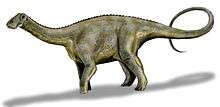
Like all sauropods, Nigersaurus was a megafaunal quadruped with a small head, thick hind legs, and a prominent tail. Among that clade, Nigersaurus was fairly small, with a body length of only 9 m (30 ft) and a femur reaching only 1 m (3 ft 3 in). It may have weighed around four tonnes, comparable to a modern elephant. It had a short neck for a sauropod, with thirteen cervical vertebrae. Nearly all rebbachisaurids had relatively short necks and a length of 10 m (33 ft) or less. The only member of the family that reached the size of larger sauropods was Rebbachisaurus.[1]
The presacral vertebrae (vertebrae before the sacrum) were heavily pneumatised to the point where the column consisted of a series of hollow "shells", each divided by a thin septum in the middle. It had little to no cancellous bone, making the centra thin bone plates filled with air spaces. The vertebral arches were so heavily pierced by extensions of the external air sacs that of their side walls little remained but 2 mm (0.08 in) thick intersecting laminae, the ridges between the pneumatic openings. The vertebrae of the tail, however, did have solid centra. The pelvic and pectoral girdle bones were very thin also, often only several millimetres thick. Like other sauropods, its limbs were robust, contrasting with the extremely lightweight construction of the rest of the skeleton. The limbs were not as specialised as the rest of the skeleton, and the front legs of Nigersaurus were about two-thirds the length of the back legs, as in most diplodocoids.[1]
Skull
.jpg)
The skull of Nigersaurus was delicate, with the four side fenestrae (openings in the skull) larger than in other sauropodomorphs. The total area of bone connecting the muzzle to the back of the skull was only 1.0 cm2 (0.16 sq in). These connecting struts of bones were usually less than 2 mm (0.08 in) thick. Despite this, the skull was resistant to the sustained shearing of the teeth. Another unique trait it had among sauropodomorphs was a closed supratemporal fenestra. The nasal openings, the bony nostrils, were elongated.[1] Though the nasal bones are not completely known, it appears the front margin of the bony nostril was closer to the snout than in other diplodocoids. The snout was also proportionately shorter, and the tooth row was not at all prognathous, the snout tip not protruding relative to the remainder of the tooth series.[2] The maxillary tooth row was in its entirety transversely rotated, its normal rear 90° everted towards the front. This was matched by an identical rotation of the dentary of the lower jaw. As a result, no other tetrapod had all of its teeth located as far to the front as Nigersaurus.[1]
The slender teeth had slightly curved crowns, which were oval in cross-section. The teeth in the lower jaw may have been 20–30% smaller than those in the upper jaw, but few are known, and they are of uncertain maturity. Apart from this, the teeth were identical.[3] Under each active tooth there was a column of nine replacement teeth within the jaw. With 68 columns in the upper jaws and 60 columns in the lower jaws, these so-called dental batteries (also present in hadrosaurs and ceratopsians) comprised a total of more than 500 active and replacement teeth.[2] Dental batteries erupted in unison, not each column individually.[3] The enamel on the teeth of Nigersaurus was highly asymmetrical, ten times thicker on the outwards facing side than on the inner side.[4] This condition is otherwise known only in advanced ornithischians.[3]
Nigersaurus did not exhibit the same modifications seen in the jaws of other dinosaurs with dental batteries, or mammals with elaborate chewing functions. The lower jaw was S-shaped and divided into the subcylindrical transverse ramus, which contained the teeth, and the back ramus, which was more lightweight and was the location for most of the muscle attachments. The jaws also contained several fenestrae, including three that are not present in other sauropods. The front ends of the jaws had grooves that indicate the presence of a keratinous sheath.[1] Nigersaurus is the only known tetrapod animal to have had jaws wider than the skull and teeth that extended laterally across the front.[5] The snout was even broader than those of the "duck-billed" hadrosaurs.[6]
History of discovery
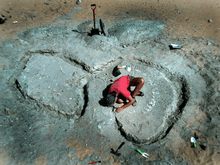
Remains thought to belong to Nigersaurus were first discovered during a 1965–72 expedition to the Republic of Niger led by French paleontologist Philippe Taquet, and first mentioned in a paper published in 1976.[2][7] Although a common genus, the dinosaur had been poorly known until more material of other individuals was discovered during expeditions led by American palaeontologist Paul Sereno in 1997 and 2000. The limited understanding of the genus was the result of poor preservation of its remains, which arises from the delicate and highly pneumatic construction of the skull and skeleton, in turn causing disarticulation of the fossils. Some of the skull fossils were so thin that a strong light beam was visible through them. Therefore, no intact skulls or articulated skeletons have been found, and these specimens represent the most complete known rebbachisaurid remains.[1][2]
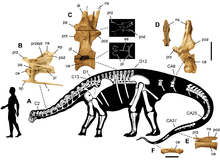
Nigersaurus was named and described in more detail by Sereno and colleagues only in 1999, based on remains of newly found individuals. The same article also named Jobaria, another sauropod from Niger. The genus name Nigersaurus ("Niger reptile") is a reference to the country where it was discovered, and the specific name taqueti honours Taquet, who was the first to organise large-scale palaeontological expeditions to Niger.[3] The holotype specimen (MNN GAD512) consists of a partial skull and neck. Limb material and a scapula found nearby were also referred to the same specimen. These fossils are housed at the National Museum of Niger.[2]
Sereno and Jeffrey A. Wilson provided the first detailed description of the skull and feeding adaptations in 2005.[2] In 2007, a more detailed description of the skeleton was published, based on a specimen discovered ten years earlier. The fossils, along with a reconstructed skeleton mount and a plastic model of the head and neck, were subsequently presented at the National Geographic Society in Washington.[8] Nigersaurus was dubbed a "Mesozoic cow" in the press, and Sereno stressed that it was the most unusual dinosaur he had ever seen. He likened its physical appearance to Darth Vader and a vacuum cleaner, and compared its tooth shear with a conveyor belt and sharpened piano keys.[5]
Teeth similar to those of Nigersaurus have been found on the Isle of Wight and in Brazil, but it is unknown whether they belonged to relatives of this taxon, or to titanosaurs, whose remains have been found in the vicinity. A lower jaw assigned to the titanosaur Antarctosaurus is likewise similar to that of Nigersaurus, but may have evolved convergently.[2]
Classification
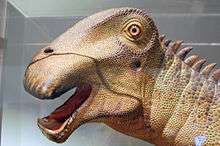
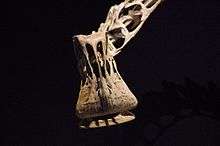
The remains of Nigersaurus were initially described in 1976 as belonging to a dicraeosaurid, but in 1999 Sereno's team reclassified it as a rebbachisaurid diplodocoid.[3] Rebbachisauridae is the basalmost family within the superfamily Diplodocoidea, which also contains the long-necked diplodocids and the short-necked dicraeosaurids. The subfamily Nigersaurinae, which includes Nigersaurus and closely related genera, was named by John A. Whitlock in 2011.[9] Below is a cladogram following an analysis by Federico Fanti and colleagues (2013), which confirmed the placement of Nigersaurus as a basal nigersaurine rebbachisaurid.[10]
| Rebbachisauridae |
| ||||||||||||||||||||||||||||||||||||||||||||||||||||||
| |
The closely related genus Demandasaurus from Spain was described in 2003, and along with other animal groups that span the Cretaceous of Africa and Europe, this indicates that carbonate platforms connected these landmasses across the Tethys Sea.[1] This was supported in 2013 by the description of the nigersaurine Tataouinea from Tunisia, which was more related to the European form than to Nigersaurus, despite being from Africa, then part of the supercontinent Gondwana.[10] The discovery of these basal diplodocoids may indicate that short necks and small size were ancestral features of the group.[1] Pneumatisation of the rebbachisaurid skeleton evolved progressively, culminating in the nigersaurines.[10] A 2015 cladistic study found Rebbachisaurus itself to group with the nigersaurines, and the authors suggested that Nigersaurinae was therefore a junior synonym of Rebbachisaurinae. Nigersaurus was the basalmost member of this "Euro-African" subclade.[11]
Palaeobiology
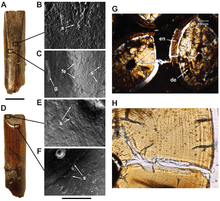
Nigersaurus was suggested by Sereno and colleagues to be a ground-level, non-selective browser. The width of the muzzle and lateral orientation of the tooth row show that the sauropod could gather much food and crop it close to the ground, within one metre of the surface.[1][2] This is further supported by facets on the labial (externally facing) side of the upper teeth, similar to Dicraeosaurus and Diplodocus, which are evidence that food or substrate wore the animal's teeth as it fed. Nigersaurus also bears signs of low-angle tooth-to-tooth wear on the inside of the maxillary crowns, which suggests that jaw movement was limited to precise up-and-down motions. Worn teeth from the lower jaw have not yet been discovered, but they are expected to show opposing tooth-to-tooth wear. The ability to raise their heads well above the ground does not necessarily mean they browsed on items there, and the short neck of Nigersaurus would have restricted the browsing range compared to other diplodocoids.[1]

The adductor muscle of the jaw appears to have attached to the quadrate instead of the supratemporal fenestra. Both this and the other mastication muscles were likely weak, and Nigersaurus is estimated to have had one of the weakest bites of the sauropods.[1] In addition, the small, nearly parallel nature of the tooth scratches and pits (caused by grit, which would not be obtained as often by high-browsers) indicate that it ate relatively soft, herbaceous plants such as low-growing ferns.[6] Because of the lateral orientation of the teeth, it probably would not have been able to chew.[2] Nigersaurus wore its tooth crowns down faster than other dinosaurian herbivores,[1] and its tooth replacement rate was the highest of any known dinosaur. Each tooth was replaced once every 14 days; the rate had previously been estimated lower. In contrast to Nigersaurus, sauropods with lower tooth replacement rates and broader tooth crowns are thought to have been canopy browsers.[4]
Though it had large nostrils and a fleshy snout, Nigersaurus had an underdeveloped olfactory region of its brain and thus did not have an advanced sense of smell. Its brain-to-body-mass ratio was average for a reptile, and smaller than those of ornithischians and non-coelurosaurian theropods. The cerebrum comprised about 30% of the brain volume, as in many other dinosaurs.[1]
Head posture

On the basis of microtomography scans of skull elements of the holotype specimen, Sereno's team created a "prototype" Nigersaurus skull they could examine. They also made an endocast of the brain and scanned the semicircular canals of its inner ear, which they found to be oriented horizontally. In their 2007 study, they stated that the structure of the occiput and cervical vertebrae would have limited the upward and downward movement of the neck and the rotation of the skull. Based on this biomechanical analysis, the team concluded that the head and muzzle were habitually oriented 67° downwards and close to ground level, as an adaptation for ground-level browsing. This is unlike the way other sauropods have been restored, with their heads held more horizontally.[1]
A 2009 study by Mike P. Taylor, Mathew Wedel, and Darren Naish agreed that Nigersaurus was able to feed with the downturned head and neck posture proposed by the 2007 study, but contested that this was the habitual posture of the animal. The study noted that the "neutral" head and neck posture of modern animals does not necessarily correspond to their habitual head posture. It further argued that the orientation of the semicircular canals varies significantly within modern species, and is therefore not reliable for determining head posture.[12] This was supported by a 2013 study that suggested the methods used by Sereno's team were imprecise, and that Nigersaurus habitually held its head like other sauropods.[13]
Palaeoecology

Nigersaurus is known from the Elrhaz Formation of the Tegama Group in an area called Gadoufaoua, located in Niger. It is one of the most commonly found vertebrates in the formation. The Elrhaz Formation consists mainly of fluvial sandstones with low relief, much of which is obscured by sand dunes.[3][14] The sediments are coarse- to medium-grained, with almost no fine-grained horizons.[1] Nigersaurus lived in what is now Niger about 115 to 105 million years ago, during the Aptian and Albian ages of the mid-Cretaceous.[3] It likely lived in habitats dominated by inland floodplains (a riparian zone).[1]
After the iguanodontian Lurdusaurus, Nigersaurus was the most numerous megaherbivore.[1] Other herbivores from the same formation include Ouranosaurus, Elrhazosaurus, and an unnamed titanosaur. It also lived alongside the theropods Kryptops, Suchomimus, and Eocarcharia, and a yet-unnamed noasaurid. Crocodylomorphs like Sarcosuchus, Anatosuchus, Araripesuchus, and Stolokrosuchus also lived there. In addition, remains of a pterosaur, chelonians, fish, a hybodont shark, and freshwater bivalves have been found.[14] Grass did not evolve until the late Cretaceous, making ferns, horsetails, and angiosperms (which had evolved by the middle Cretaceous) potential food for Nigersaurus. It is unlikely the dinosaur fed on conifers, cycads, or aquatic vegetation, due respectively to their height, hard and stiff structure, and lack of appropriate habitat.[1]
References
- 1 2 3 4 5 6 7 8 9 10 11 12 13 14 15 16 17 18 Sereno, P. C.; Wilson, J. A.; Witmer, L. M.; Whitlock, J. A.; Maga, A.; Ide, O.; Rowe, T. A. (2007). "Structural extremes in a Cretaceous dinosaur". PLoS ONE. 2 (11): e1230. Bibcode:2007PLoSO...2.1230S. doi:10.1371/journal.pone.0001230. PMC 2077925
 . PMID 18030355..
. PMID 18030355.. 
- 1 2 3 4 5 6 7 8 9 Wilson, J. A.; Sereno, P. C. (2005). "Structure and evolution of a sauropod tooth battery". In Curry Rogers, K.; Wilson, J.A. The Sauropods: Evolution and Paleobiology (PDF). University of California Press. pp. 157–177. ISBN 0-520-24623-3.
- 1 2 3 4 5 6 7 Sereno, P. C.; Beck, A. L.; Dutheil, D. B.; Larsson, H. C.; Lyon, G. H.; Moussa, B.; Sadleir, R. W.; Sidor, C. A.; Varricchio, D. J.; Wilson, G. P.; Wilson, J. A. (1999). "Cretaceous sauropods from the Sahara and the uneven rate of skeletal evolution among dinosaurs". Science. 286 (5443): 1342–1347. doi:10.1126/science.286.5443.1342. PMID 10558986.
- 1 2 D’Emic, M. D.; Whitlock, J. A.; Smith, K. M.; Fisher, D. C.; Wilson, J. A. (2013). Evans, A. R., ed. "Evolution of high tooth replacement rates in sauropod dinosaurs". PLoS ONE. 8 (7): e69235. doi:10.1371/journal.pone.0069235. PMC 3714237
 . PMID 23874921.
. PMID 23874921. 
- 1 2 Joyce, C. (2013-11-25). "'Mesozoic Cow' Rises from the Sahara Desert". NPR. Retrieved 2007-11-16.
- 1 2 Whitlock, J. A. (2011). Farke, A. A., ed. "Inferences of diplodocoid (Sauropoda: Dinosauria) feeding behavior from snout shape and microwear snalyses". PLoS ONE. 6 (4): e18304. Bibcode:2011PLoSO...618304W. doi:10.1371/journal.pone.0018304. PMC 3071828
 . PMID 21494685.
. PMID 21494685. 
- ↑ Taquet, P. (1976). "Géologie et paléontologie du gisement de Gadoufaoua. (Aptien du Niger)" (PDF). Cahiers de paléontologie (in French). Paris: 53. ISBN 2-222-02018-2.
- ↑ Ross-Flanigan, N. (2007). "U-M researchers study toothy, ground-feeding dinosaur". University of Michigan. Archived from the original on October 12, 2013. Retrieved 2013-12-19.
- ↑ Whitlock, J. A. (2011). "A phylogenetic analysis of Diplodocoidea (Saurischia: Sauropoda)". Zoological Journal of the Linnean Society. 161 (4): 872–915. doi:10.1111/j.1096-3642.2010.00665.x.
- 1 2 3 Fanti, F.; Cau, A.; Hassine, M.; Contessi, M. (2013). "A new sauropod dinosaur from the Early Cretaceous of Tunisia with extreme avian-like pneumatization". Nature Communications. 4: 2080. Bibcode:2013NatCo...4E2080F. doi:10.1038/ncomms3080. PMID 23836048.
- ↑ Fanti, F.; Cau, A.; Cantelli, L.; Hassine, M.; Auditore, M. (2015). "New Information on Tataouinea hannibalis from the Early Cretaceous of Tunisia and Implications for the Tempo and Mode of Rebbachisaurid Sauropod Evolution". PLoS ONE. 10 (4): e0123475. doi:10.1371/journal.pone.0123475. PMC 4414570
 . PMID 25923211.
. PMID 25923211. 
- ↑ Taylor, M. P.; Wedel, M. J.; Naish, D. (2009). "Head and neck posture in sauropod dinosaurs inferred from extant animals". Acta Palaeontologica Polonica. 54 (2): 213–220. doi:10.4202/app.2009.0007.
- ↑ Marugán-Lobón, J. S.; Chiappe, L. M.; Farke, A. A. (2013). "The variability of inner ear orientation in saurischian dinosaurs: Testing the use of semicircular canals as a reference system for comparative anatomy". PeerJ. 1: e124. doi:10.7717/peerj.124. PMC 3740149
 . PMID 23940837.
. PMID 23940837. - 1 2 Sereno, P. C.; Brusatte, S. L. (2008). "Basal abelisaurid and carcharodontosaurid theropods from the Lower Cretaceous Elrhaz Formation of Niger". Acta Palaeontologica Polonica. 53 (1): 15–46. doi:10.4202/app.2008.0102.
External links
| Wikimedia Commons has media related to Nigersaurus. |
- National Geographic Live! - Extreme Dinosaurs - lecture about the discovery of Nigersaurus by Paul Sereno
- National Geographic Live! - Bringing Back Nigersaurus - video about the reconstruction of a Nigersaurus skeleton